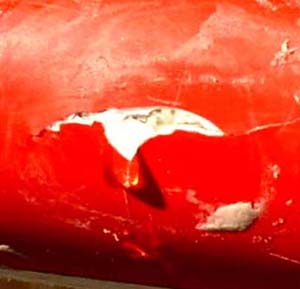|
| |
| Water in the Board
As beneficial as water
generally is in our lives, it can be detrimental to our boards. Given half a
chance, it will rush in there, wreak havoc with performance and structure,
and be enormously resistant to being extracted again.
How
come?
|
 |
| You take your bright red
go-fast whizbang down from the car's roof, and, as you tighten the vent
screw, notice how warm the deck feels . Warm-to-the-touch means warmer than 98 degrees.
The water has been getting warmer, you notice as you wade in, but it is
still only 64 degrees. As you lower the board into the water, you briefly
wonder if that piece of tape you slapped onto last weekend's rail crunch is
still doing its appointed job. But here comes a good gust, and away you go.
Your board's temperature is rapidly dropping from the
roof-topped 98-plus
degrees down to the water's 64 degrees. As the air inside the EPS foam cools along with the rest of the board, it contracts, reducing the
pressure within the board.
If that bit of tape on the rail crunch holds, then
this reduced pressure will only cause a slight thinning of the board, maybe
a bit of a depression at soft spots on deck. But if that tape has fallen
off, then your board will eagerly suck in water for the duration of the
cooling-off period. Prodigious quantities can be inhaled this way.
The day turns out gorgeous, you stay out for 3hrs. As
you carry the board back to the car, you think it might feel a little heavy,
and you notice that the piece of tape on the rail crunch has
departed. Better to stop by my shop on the way home, then, and have it
fixed.
I put your board on the scale and inform you that it
now weighs 3# more than when you last visited. About one of those pounds is
harmless water contained in Padz and straps. Which leaves about 2# of water
in the EPS core. Dang!
I tell you that - the impending Santa Ana
notwithstanding, so very sorry - I will need to keep your board for at least
10 days. And that even at that, I cannot guarantee total drying.
It took only 3 hrs to take on this water. Why then 10
days to shed it again??
|
The inhalation
occurred primarily due to pressure differences, causing a substantial flow
of solid water through even a very small orifice.
Evacuation of water occurs primarily due to
evaporation, which requires energy to cause water molecules to mobilize; and
air exchange, to carry off these mobilized molecules. For this air exchange,
we can generally only offer a 5/16" diameter vent fixture. That's less
than 1/10th
square inches, to evaporate moisture out of the approx 30 liters of air that
is free to move in the EPS channels of a 100 liter board. The resulting
evaporation rate is dismal, to put it mildly, hence the length of time
required.
Think of a wet towel: you hang it up on the line,
with a dry 75 degree breeze flapping it about, and it will be bone-dry by
nightfall. But bunch it up, throw it in the hamper, and it will still be wet
next week. Little surface area, little energy to mobilize the water
molecules, little air flow to carry them off.
Under normal circumstances, your board is like that wet towel in the hamper.
Or worse, if you zip it up in a foil bag. But there are things we can do to
improve matters a bit! |
|
return to water, water everywhere |
|